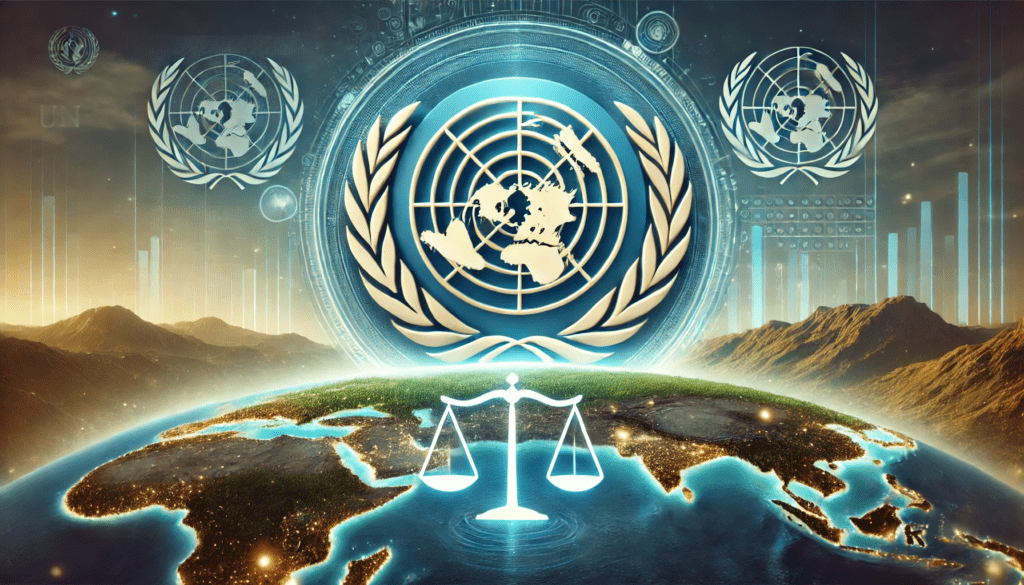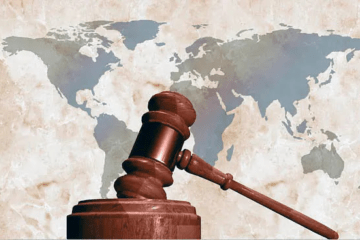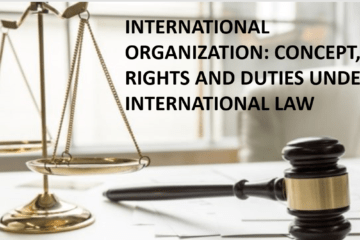
This article is written by Akshita Gupta of 1st Semester of Bennett University, an intern under Legal Vidhiya
ABSTRACT
The United Nations (UN) was established with the primary objective of maintaining international peace and security. One of its most significant mechanisms for achieving this goal is peacekeeping, a unique tool that helps conflict-ridden regions transition from instability to peace. UN peacekeeping operations are designed to assist countries in post-conflict recovery, support democratic processes, and protect civilians.
This research examines peacekeeping through exploring its global security maintenance role and identifying the relevant legal structures which direct United Nations peacekeeping operations. Further it examines the role of the UN in global peacekeeping by exploring its legal framework, guiding principles, and the challenges it faces in conflict resolution. The study begins by defining peacekeeping and its importance in maintaining global stability. It then delves into the legal foundation of UN peacekeeping, focusing on the principles of consent, impartiality, and the non-use of force except in self-defense or defense of the mandate. The paper further evaluates the effectiveness of UN peacekeeping through two case studies: the successful mission in Namibia and the failure in Rwanda.
Ultimately, this paper argues that while UN peacekeeping remains an essential instrument for conflict resolution, its success is contingent on political commitment, adequate resources, and clear mandates. Strengthening peacekeeping mechanisms is crucial for ensuring that the UN remains a reliable force for global peace and security in the 21st century.
INTRODUCTION
Established in 1945 after World War II the United Nations (UN) exists to ensure worldwide peace and security. [1]The destruction from World War II demonstrated a crucial requirement for an international body which would protect peace through diplomatic resolution systems. When the United States began its Cold War against the Soviet Union traditional diplomatic and collective security policies failed to match peacekeeping needs. The United Nations created peacekeeping operations as a distinct mechanism to assist conflicts and enforce ceasefires and help reconstruction efforts without using direct military forces.
After World War II the United Nations Truce Supervision Organization (UNTSO)[2] became the initial peacekeeping mission to supervise an Arab-Israeli ceasefire in 1948.[3] Throughout successive decades UN peacekeeping operations transformed into operations which expanded from basic military observation missions to encompass civilian protection together with humanitarian assistance and nation-building tasks. Peacekeeping missions in Cambodia, East Timor, and Namibia earned substantial appreciation yet Somalia, Bosnia, and Rwanda demonstrated profound failures.
The paper further analyzes the effectiveness of peacekeeping through two case studies: the success of the UN Transition Assistance Group (UNTAG) in Namibia[4] and the failure of the UN Assistance Mission for Rwanda (UNAMIR).[5] Namibia proves that well-executed United Nations interventions successfully create peaceful conditions which bring about independent governance. The Rwandan genocide of 1994 demonstrates how UN failures in response led to massive deaths after the international organization did not take decisive action during this genocide.
The effectiveness of United Nations peacekeeping missions relies on four essential factors: political support from states, precise instructions, enough available funding and a smooth operational timing. The Namibian success when compared with Rwandan failure demonstrates how United Nations peacekeeping missions function and their achievement capabilities and realistic operational boundaries. Peacekeeping mechanisms require strengthening to make the UN an effective force which maintains international peace and security into the coming years.
WHAT IS PEACEKEPING?
“Peace is a fulltime job. It’s protecting civilians, overseeing elections, and disarming ex-combatants”.[6]
Peacekeeping operations exist as military missions which strive to establish conditions that lead to enduring peace. Actions of peacekeeping forces work to defend civilians while stopping conflicts along with minimizing violent actions.
The peacekeeping field includes a wide variety of different operational approaches. According to the analysis in Page Fortna’s Does Peacekeeping Work? [7] She defines four specific peacekeeping mission designs. Operating parameters and mission performance strongly depend upon the authorizing directives of these operations. All except one of Fortna’s four mission categories are consent-based peacekeeping operations known as Chapter VI missions while the fourth category falls under Chapter VII missions. When operating Chapter VI missions belligerent factions present at the conflict zone must grant their consent for the missions to proceed. Peacekeeper operations would necessitate disengagement when belligerent factions withdraw their permission. Mission execution under Chapter VII functions without necessity of recipient consent while consent can still be present. The mandate of Chapter VII missions provides no obligation to withdraw operationally because consent is lost at any time.
- Observation Missions deploy armed or unarmed groups that monitor ceasefire agreements through military or civilian observers who observe unilateral troop movements and cessation of hostilities according to peace accord provisions. The primary duty of these missions involves passive unarmed observation because their mandate restricts them to documentation activities. The peacekeeping missions do not have enforceable capacity or authoritatative power to respond if any party breaks the terms of their agreement.
- Interposition Missions devote larger troop numbers to security positions in order to create intermediary forces between fighting sides following any conflict. During a ceasefire these missions create protected space between conflicting factions to observe how parties stick to the commitments outlined in the ceasefire deal.
- Multidimensional mission include the role ofmilitary and police personnel, they execute interpositional roles as well as electoral supervision and police and security forces reform alongside institution building and economic development efforts. The implementation of strong and extensive settlements constitutes the essential goal of multidimensional missions which military and police forces execute.
- Peace enforcement Missions labeled as Chapter VII operate independently of the belligerent parties’ consent because they follow different mandates. Such missions unite a military force with selected civilian personnel through multidimensional operational tasks. UN Peacekeeping standards define the military forces as large-sized units together with appropriate equipment. Besides their right to defend themselves peacekeepers receive orders allowing them to utilize force beyond defensive scenarios. [8]
SIGNIFICANCE OF UN IN CONFLICT RESOLUTION
The significance of the United Nations in conflict resolution extends to various facets, including post-conflict recovery, state-building, humanitarian assistance, and human rights protection:
1. Role in Post-Conflict Recovery and State-Building:
Post-conflict recovery calls for United Nations involvement as it helps rebuild fundamental implementation systems of the state including governance structures and legal systems and public services. UN peacekeeping operations together with its special political missions work to preserve stability and stop conflicts from restarting. Through its support mechanisms the UN promotes both political inclusivity and the involvement of all stakeholders including disadvantaged communities during recovery initiatives .Economic reconstruction ,through its economic support programs the UN promotes sustainable development and refugee return assistance while simultaneously facilitating reconstruction of vital infrastructure.
2. Contributions to Humanitarian Assistance and Human Rights Protection:
Through the work of programs like the UNHCR[9] and UNICEF [10]within conflict zones the United Nations offers vital humanitarian aid that includes providing food with shelter and medical care as well as educational programs for affected people. Through its Human Rights Council together with peacekeeping operations and collaborations with international courts the UN protects human rights. And with the Geneva Conventions and other efforts the UN develops international humanitarian law which establishes legal frameworks to protect civilians and combatants during wartime conflicts .Through its efforts the UN promotes mechanisms which handle war crimes and human rights violations during conflicts while advancing justice and social unity.
Through its combination of peacekeeping operations with human rights protection and humanitarian relief assistance the United Nations functions as the primary actor in resolving conflicts as well as supporting sustainable peace-building efforts.
CASE STUDIES; SUCCESS AND FAILURE OF UN PEACEKEEPING
- Success case study : Namibia( UNTAG) 1989 – 1990
The achievement of United Nations Transition Assistance Group (UNTAG) in Namibia from 1989 to 1990 provides significant evidence for productive United Nations state-building and conflict resolution operations. [11]
Background: Namibia fought for decades under South African control before international involvement proved necessary to achieve peaceful post-independence outcomes.
Role of UNTAG: UNTAG took control of supervising ceasefire implementation between consenting sides while overseeing democratic voting and providing support during Namibia’s transition to independence. Through ongoing observation UNTAG monitored political developments along with security protocols while ensuring the weapons removal from fighting forces.
Factors Behind Success: UNTAG accomplished its mission through multiple variables working together successfully. Strong international support especially through the UN Security Council brought essential pressure on South Africa during the transition. UNTAG accomplished its peace objectives because it received both a specific mission mandate during Operation Desert Storm alongside firm support from South Africa along with the South West Africa People’s Organization (SWAPO).[12] The mission utilized appropriate resources with skilled staff who successfully delivered the mandated operations.
Impact: After UNTAG’s successful work Namibia gained stable independence during 1990 before becoming a democratic nation. Peacekeeping operations in conflict areas received their benchmark from UNTAG’s victorious end which simultaneously delivered freedom to Namibia.
The United Nations Transition Assistance Group’s (UNTAG) success in Namibia proves that UN-led peace operations and state-building missions successfully resolve conflicts to create peaceful transitions. Regional power backing together with precise directives and stakeholder involvement and sufficient funding and qualified personnel led Namibia to secure stable independence and set up its democratic system. This case-example demonstrates how the United Nations leads crucial post-conflict recovery efforts which should become the basis for future peace support operations across conflict zones aiming to create enduring peace and development
- FAILURE CASE STUDY : RWANDA (UNAMIR) 1993 – 1996 [13]
Background: Rwanda demonstrated prolonged historical conflict between its Hutu population which predominated and its smaller Tutsi ethnic group. In 1990 the Rwandan Patriotic Front (RPF) launched a Tutsi-led rebel assault that initiated a civil war. The Arusha Accords of 1993 established peace in Rwanda which led United Nations to send UNAMIR United Nations Assistance Mission for Rwanda. Genocide erupted after President Juvénal Habyarimana’s assassination in April 1994 when extremist Hutu militias slaughtered more than 800,000 Tutsis and moderate Hutus within 100 days.
Role of UNAMIR: When established UNAMIR received instructions to monitor compliance with the Arusha Accords while helping peace efforts progress. Canadian General Roméo Dallaire commanded the UNAMIR mission without adequate forceful intervention powers. General Dallaire warned about a planned mass killing spree yet the United Nations and supporting international bodies refused to initiate decisive intervention. UN forces experienced reduced troop numbers when genocide started yet required more troops to stop the violence.
Reasons for Failure: The mandate of UNAMIR lacked authority to employ force therefore preventing the force from taking necessary action to protect civilians. The operation experienced difficulties because of limited troops combined with insufficient available funding and unmanageable logistical problems. The UN Security Council paused from taking action primarily because of France and the United States’ unwillingness to act. Reinforcements received UN approval too late after most genocide events had concluded.
Impact: More than 800,000 innocent individuals suffered brutal death during this period. The United Nations peacekeeping operation generated extensive worldwide condemnation due to major shortcomings in its system that became publicly visible. Behind the horrific events rapidly revealed the necessity of expanding the mandates that direct peacekeeping operations. After international assessments showed how the UN failed the world accepted the organization needed improvement and implemented both leadership changes in its peacekeeping practices and the Responsibility to Protect (R2P) standard.
The failure of UNAMIR in Rwanda stands as one of the most tragic examples of the UN’s inability to prevent mass atrocities despite clear warning signs. The mission was undermined by a weak mandate, inadequate resources, and a lack of political will from the international community. The delayed response allowed the genocide to unfold, resulting in the deaths of over 800,000 people. Ultimately, the Rwandan genocide remains a stark reminder of the catastrophic consequences of inaction and the need for a more effective and decisive international response to humanitarian crises.
NEED FOR REFORMS IN PEACEKEEPING
Across the globe peacekeeping by the UN holds an essential position in achieving conflict settlement. The history of United Nations peacekeeping reveals major weaknesses through failed missions from Rwanda 1994 to Srebrenica 1995 along with current difficulties in Mali and the Central African Republic. The persistent shortcomings demonstrate an absolute necessity for substantial reform efforts which will improve both accountability and responsiveness in future peacekeeping operations.
1. Strengthening Mandates
An important shortcoming of United Nations peacekeeping operations stems from insufficiently precise and powerful mission mandates. Missions often receive mandated authority restrictions that prevent them from actively addressing current conflict activities. Key reforms should include:
- Clearer Rules of Engagement: Peace missions need clear legal powers of force so they can act to safeguard civilian lives and stop mass killings and stop aggressors’ threatening actions.
- Shift from Traditional Peacekeeping to Peace Enforcement: The premises of traditional peacekeeping depend on stable ceasefires and peace agreements as blocks of existing conditions yet contemporary conflicts frequently remain active. Peace enforcement capabilities need to become part of peacekeeping mandates because they enable proactive operations.
- Preemptive Action against Genocide and War Crimes: The United Nations requires stronger authority to allow missions to respond to potential atrocities even before Security Council delays through political disagreements occur.
- More Flexible and Adaptive Mandates: Peacekeeping operations require the capability to modify their approaches when conditions in specific conflict regions alter.
2. Improving Deployment & Resources
Peacekeeping operations face unsteady results when troops retain deployment delays and lacking resources are deployed by historical evidence. To address this, the UN must:
- Create a Rapid Deployment Force: A preformed standby troop unit accessible in brief durations would enable the UN to rapidly answer developing crises.
- Enhance Logistical and Technological Capabilities: The UN must deliver modern surveillance capabilities alongside intelligence systems and sustained military equipment to missions for successful operations.
- Ensure Better Training for Peacekeepers: Effectiveness improves when peacekeeping forces receive training which combines conflict resolution skills alongside cultural sensitivity practices and humanitarian crisis management knowledge.
- Increase Financial Contributions: Multiple United Nations peacekeeping operations face an ongoing problem with limited financial support. The UN should demand stronger financial responsibilities of its member states to guarantee mission resources.
3. Increasing Political Support & Commitment
The decisions and reaction rates in peacekeeping operations often suffer interference from dominant United Nations member states because of their political power. Reforms should include:
- Reducing Dependency on the Security Council: Action delays on the United Nations Security Council become frequent because the permanent members (U.S., China, Russia, France and UK) constantly utilize their positions to accumulate political benefits. More powerful decision authority should rest with either regional organizations or an independent peacekeeping entity run by the United Nations.
- Enhancing Cooperation with Regional Organizations: Peacekeeping organizations should expand their presence in conflicts by allowing the African Union (AU) and European Union (EU) alongside other existing regional entities to lead essential missions because they possess superior local conflict understanding.
- Increasing Contributions from Developed Nations: The wealthier nations supply financial help; however these states restrict deployments of their military forces to actual conflict zones. A uniform distribution of military units between member states would deliver strengthened outcomes in international peacekeeping operations.
- Strengthening Political Commitment from Member States: Member states should refrain from shifting their support or military forces because of political reasons. Peacekeeping needs a lasting permanence framework that member states establish through formal treaties.
4. Enhancing Accountability & Transparency
Criticism has targeted UN peacekeeping operations for their unacceptable misbehavior alongside corruption as well as their operational inefficiency. To restore trust, reforms should focus on:
- Establishing Stronger Oversight Mechanisms: Independent evaluations must check peacekeeping mission performance while delivering excessive data to all international authorities.
- Holding Peacekeepers Accountable for Misconduct: Military peacekeepers need to face immediate and severe legal consequences when they engage in sexual assault or corruption or violate human rights.
- Improving Engagement with Local Communities: Proper peacekeeping mandates require extensive local engagement because this ensures peacekeepers both understand community needs and overcome cultural misunderstandings in order to reach mission objectives.
- Ensuring Exit Strategies and Post-Mission Support: The absence of defined exit plans following peacekeeping operations generates instability because most missions finish without proper transition procedures. The deployment of peacekeepers must integrate structured post-conflict reconstruction planning within their every mandate
By embracing these reforms, UN peacekeeping can become a more reliable tool for preventing conflicts, protecting civilians, and ensuring lasting peace in the world’s most vulnerable regions.
CONCLUSION
Peacekeeping conducted by the United Nations stands as a central yet seriously inadequate method to sustain global international security. Successful peace operations in Namibia exhibit how strong interventions work yet the Rwandan failures reveal that weak mandates coupled with inadequate resources combined with insufficient political backing cause extreme damage. Peacekeeping strategies operated by the UN need evolution according to the growing complexity of modern conflicts which now include both civil conflicts and transnational terrorist movements. A reformed peacekeeping framework must prioritize stronger mandates, rapid response capabilities, and enhanced political commitment from member states. Future peace operations should move beyond traditional models of military observation and embrace proactive peace enforcement, ensuring timely interventions in crisis zones. Strengthening cooperation with regional organizations like the African Union (AU) and the European Union (EU) can also enhance operational effectiveness by leveraging localized expertise.
The United Nations must firmly recommit itself to implementing the Responsibility to Protect (R2P) framework to ensure peacekeeping operations translate from being politically expedient tools to definitive human rights defense and worldwide peace preservation mechanisms. History will replicate itself with countless unintended deaths if world authorities fail to take decisive measures.
The survival of UN peacekeeping missions requires powerful shared efforts to enact reforms while establishing accountability systems combined with prompt responses toward advancing global security.
REFERENCES
- Page Fortna, Does Peacekeeping Work? Shaping Belligerents’ Choices After Civil War, 36 Int’l Org. 469 (2008), available at https://www.jstor.org/stable/3693574.
- Laura Janik, Female Peacekeepers and Operational Effectiveness in UN Peace Operations, 20 Global Pol. Rev. 155 (2020), available at https://www.jstor.org/stable/resrep25749.
- Leon Hartwell, SADC Peacekeeping Missions and the Quest for Regional Security, in Peacebuilding in Southern Africa 139 (John Elavsky ed., Springer 2023), available at https://link.springer.com/chapter/10.1007/978-3-031-56695-0_8.
- Christopher Daase, Who Keeps the Peace? Understanding State Contributions to UN Peacekeeping Operations, 61 Int’l Stud. Q. 150 (2017), available at https://academic.oup.com/isq/article-abstract/61/1/150/2725414.
- Thomas Weiss, Peacemaking in Somalia: AU and UN Peace Operations, in The UN and Regional Organizations in Global Security 59 (Springer 2018), available at https://link.springer.com/chapter/10.1007/978-3-319-62202-6_8.
- Michael Doyle & Nicholas Sambanis, Making War and Building Peace: United Nations Peace Operations, 1 Global Pol. Rev. 201 (2000), available at https://www.jstor.org/stable/pdf/26569511.pdf.
- United Nations Peacekeeping, What We Do, UN Peacekeeping, available at https://peacekeeping.un.org.
- United Nations, Report of the Independent Inquiry into the Actions of the United Nations during the 1994 Genocide in Rwanda, U.N. Doc. S/1999/1257 (Dec. 15, 1999), available at https://digitallibrary.un.org/record/405039.
[1] United Nations, History of the United Nations, available at https://www.un.org/en/about-us/history-of-the-un.
[2] UNITED NATIONS, https://untso.unmissions.org/ (last visited Jan. 26, 2025)
[3] United Nations Transition Assistance Group (UNTAG), United Nations Peacekeeping, UNITED NATIONS, https://peacekeeping.un.org/en/mission/untag (last visited Jan. 26, 2025)
[4] United Nations, UNTAG in Namibia: A New Nation is Born, DIGITAL LIBRARY, https://digitallibrary.un.org/record/101576?ln=en (last visited Jan. 26, 2025)
[5] Roméo Dallaire, Shake Hands with the Devil: The Failure of Humanity in Rwanda 199–201 (2003)
[6] George Clooney, Peace is a fulltime job. It’s protecting civilians, overseeing elections, and disarming ex-combatants. Peace, like war, must be waged., QUOTEFANCY, https://quotefancy.com/quote/1137455/George-Clooney-Peace-is-a-fulltime-job-It-s-protecting-civilians-overseeing-elections-and (last visited Jan. 26, 2025)
[7] Virginia Page Fortna, Does Peacekeeping Work? Shaping Belligerents’ Choices After Civil War 145 (2008)
[8] Peacekeeping, What is Peacekeeping?, UNITED NATIONS PEACEKEEPING, https://peacekeeping.un.org/en/what-is-peacekeeping (last visited Jan. 26, 2025)
[9] UNITED NATIONS HIGH COMMISSIONER FOR REFUGEES, https://www.unhcr.org (last visited Jan. 26, 2025)
[10] United Nations Children’s Fund (UNICEF), UNICEF Official Website, https://www.unicef.org (last visited Jan. 26, 2025)
[11] UNITED NATIONS, https://peacekeeping.un.org/mission/past/untag.htm (last visited Jan. 26, 2025)
[12] SWAPO Party of Namibia, Constitution of the South West Africa People’s Organization, Namibia Digital Repository, https://www.namibiadigitalrepository.com/items/show/469 (last visited Jan. 26, 2025)
[13] Roméo Dallaire, Shake Hands with the Devil: The Failure of Humanity in Rwanda 199–201 (2003)
Disclaimer: The materials provided herein are intended solely for informational purposes. Accessing or using the site or the materials does not establish an attorney-client relationship. The information presented on this site is not to be construed as legal or professional advice, and it should not be relied upon for such purposes or used as a substitute for advice from a licensed attorney in your state. Additionally, the viewpoint presented by the author is personal.




0 Comments